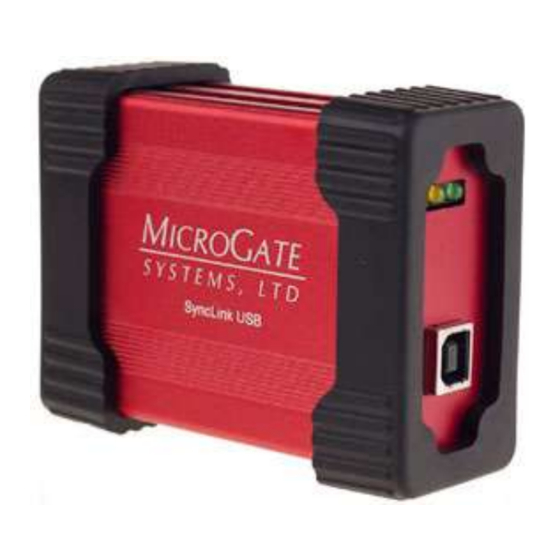Table of Contents

Summary of Contents for Microgate SyncLink USB
- Page 1 SyncLink USB Serial Adapter Hardware User’s Manual MicroGate Systems, Ltd http://www.microgate.com MicroGate® and SyncLink® are registered trademarks of MicroGate Systems, Ltd. Copyright © 2012-2017 MicroGate Systems, Ltd. All Rights Reserved...
-
Page 2: Table Of Contents
Contents Overview ............................... 4 Features ..............................4 Specifications ............................4 LED Indicators ............................... 5 Troubleshooting ............................5 All LEDs Off ............................5 Red LED Only ............................5 Yellow LED Only ............................ 5 Green LED On ............................6 Signal Specifications ............................6 Single Ended Signals (RS-232/V.28) ...................... - Page 3 Frequency Synthesizer ..........................17...
-
Page 4: Overview
Overview The SyncLink USB Serial Adapter is an external device that connects a host computer USB port to a synchronous serial port. The adapter provides a single serial port for use by the system. Multiple SyncLink USB adapters may be attached to the same computer or powered USB hub. A variety of serial protocols and interface standards are supported. -
Page 5: Led Indicators
Device is ready for use. Red = Transmit Data, Yellow = Receive Data Troubleshooting Try these steps if the SyncLink USB is plugged into a USB port and not functioning as expected: All LEDs Off Verify host system or USB hub is turned on and powered. -
Page 6: Green Led On
Green LED On Monitor the red LED (transmit) and yellow LED (receive) for indications of data transfer. These are only valid when the green LED is on. If you see no data, verify cabling, serial interface selection (RS232, V.35, RS530, etc), serial protocol settings and remote device status. Signal Specifications Each serial signal (control, status, data, or clock) is compatible with an electrical specification that is selected through software settings. -
Page 7: Serial Interface Selection
The assignment of clock edges to transmit data transition and receive data sampling is referred to as clock polarity. The SyncLink USB uses the clock polarity in the RS-232/RS-422/V.24/V.28/V.11 standards as described below: RS-232/V.28 Single Ended Signals ... -
Page 9: Serial Connector Pin Assignments
The assignment of signals to the connector pins is controlled by the software interface selection. For interface types that use a connector different than DB-25 an adapter cable purchased from MicroGate is required. The following sections describe the software settings and cables for each supported standard. -
Page 10: V.35
V.35 The V.35 standard uses a mix of single ended and differential signals on a 34-pin block connector. To use this standard, select V.35 in software and use the MicroGate V.35 cable (Part # 2534GT, picture shown below). Note that the LL, RL, and RI signals are available on the adapter’s DB-25 connector when the V.35 interface is selected, but are not available (NC = no connect) on the 34-pin block connector when using the V.35 cable. -
Page 11: Rs-422/Rs-449/Rs-485/Rs-530
RS-422/485. Use any straight through 25 conductor DB-25M to DB-25F cable (such as MicroGate Part # CMF000) to connect the adapter to RS-530 communications equipment. RS-449 uses differential signals on a DB-37 connector. To use this standard, select RS-422/485 in software and use the MicroGate RS-449 cable (Part # 2537FM). - Page 12 Figure 3 RS-530 Cable (Part# CMF000) Figure 4 RS-449 Cable (Part# 2537FM )
-
Page 13: Rs-530A
RS-530A RS-530A is similar to RS-530, except DTR and DSR outputs are single ended instead of differential. RS-530A Male DTE Signal Name Electrical Desc DB25 Direction RS-530A Pin # Earth/Shield Ground TxD (-/A), Transmit Data RS-422/V.11 Output RxD (-/A), Receive Data RS-422/V.11 Input RTS (-/A), Request to Send... -
Page 14: X.21
X.21 is an interface standard using differential signals on a DB-15 connector. To use this standard, select RS-422/485 in software and use the MicroGate X.21 cable (Part # 2515FM). The X.21 signal names are different than those used by the adapter and other interface standards. The mapping of the X.21 signals to the adapter signals are shown in the table below. -
Page 15: General Purpose I/O Signals
General Purpose I/O Signals The SyncLink USB has a 24-pin header (2 x 12 pins, 0.050” spacing) inside the case and on the circuit board that provides general-purpose input/output (GPIO) signals for application specific uses. These signals are controlled by an application using the serial API (Windows and Linux). Each signal can be configured to be either an input or an output. - Page 16 The SyncLink USB adapter has a total of 20 general purpose I/O signals (GPIO[0] to GPIO[19]). By default on power up all GPIO signals are configured as inputs (direction control = 0). Refer to the serial API documentation for details on configuring and using GPIO signals.
- Page 17 GPIO[22] Clock SPI Interface The SyncLink USB has a fixed frequency crystal that drives the reference clock input of a variable frequency synthesizer. The default crystal frequency is 14.7456MHz, and on power up the synthesizer outputs the same frequency on CLK1 (pin 8) which is used as the standard base clock by the serial controller.



Need help?
Do you have a question about the SyncLink USB and is the answer not in the manual?
Questions and answers
How to change the SyncLink Port to MGHDLC1 and 2 instead of MGHDLC3 and 4. Tried going to the SyncLink Adapter advanced device but there is the only option with MGHDLC3 and 4 so I cannot change it there.
The port numbers (e.g., MGHDLC1, MGHDLC2) are assigned by the operating system and may vary depending on the USB port used or the order in which devices are connected. To change the SyncLink USB port to MGHDLC1 and 2 instead of MGHDLC3 and 4, try the following steps:
1. Unplug all SyncLink USB devices from the system.
2. Reboot the system.
3. Plug in the desired SyncLink USB device first. It should be assigned MGHDLC1 and 2.
4. Plug in additional devices afterward if needed.
This order helps the system assign lower port numbers to the device plugged in first.
This answer is automatically generated